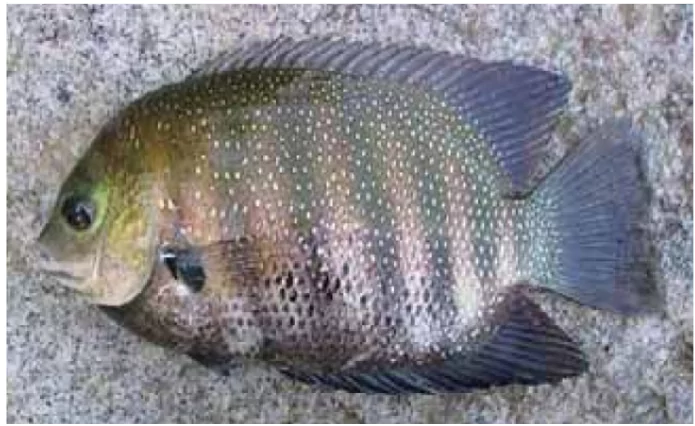Kerala University of Fisheries and Ocean Studies (Kufos) is set to launch a genome editing mission to revolutionize aquaculture and boost pearl spot production.
- Purpose: To target the genetic makeup of the fish inhibiting faster rate of growth. It would also help enhance breeding and seed production of pearl spots.
- The DNA sequencing of pearl spots was expected to be available in the public domain soon.
About Pearl Spot Fish

- Scientific Name: Etroplus suratensis and commonly known as “Karimeen” in Kerala.
- Native Species: Pearl spots are a high valued food fish endemic to peninsular India and Sri Lanka.
- Recognition: The species was declared as the ‘State fish of Kerala’ in the year 2010.
- Potential for aquaculture:
- The pearl spot has high market demand, hardy nature, non-predatory habits and ability to breed naturally in confined waters making it a suitable candidate for aquaculture.
- Features:
- Habitat: Pearlspot is a euryhaline fish, thriving well in brackish waters and has the ability to live both in fresh and saline waters.
- Feeding habits: It is an omnivorous detritus feeder which feeds mainly on plankton, small worms, prawns and algae with Periphyton dominated with spirogyra being its favorite food.
- Breeding habits: It has an asynchronous type of ovary which indicates its continuous spawning habit. It breeds throughout the year with two peaks during the monsoons.
- Breeding behavior involves pairing, courtship, chasing, nest making and parental care.
- Physical Attributes: Pearl spots have an elevated laterally compressed body and a small cleft mouth.
- Coulor: In the natural habitat, the fish is light green in color with eight vertical bands.
- Scales: Most of the scales above the lateral line have a pearly white spot and some irregular black spots are seen on the abdominal scales.
- Prone to diseases: The most common disease causing agents are bacteria including Pseudomonas, Alcaligenes, Flavobacteria, Moraxella, Vibrio and gram-positive Micrococci, Athrobacter and Bacillus spp.
Enroll now for UPSC Online Course
Pearl Spot Farming
- Culture: The pearl spot is suitable for culture in confined, fresh and brackish waters in traditional ponds in Kerala at small scale which can be harvested in 9-12 months ( achieving a body weight of 300 to 400 grams).
- It is cultured in the traditional manner, in the ‘Pokkali’ fields.
- Annual Production: Kerala produces around 2,000 tonnes of pearl spots annually against the market demand for about 10,000 tonnes as per 2020 estimates.
- Seed production: Seed of pearl spot is available throughout the year along the east and south-west coasts of India with the peak season being during the months of May-July and November-February.
- Method of seed collection: In this method twigs or branches are kept submerged in the water a week before the day of collection taking advantage of the tendency of the fish to congregate in large numbers for feeding on epiphytic growth.
- Spawning Surfaces:
- Natural Environment: The fish attaches its eggs to submerged substrata like stones, aquatic plants etc.
- Cultured Environment: In a prepared pond materials like palmyrah leaves tied in bunches to fixed poles, coconut leaf petioles, coconut husks, bricks, pieces of asbestos sheets etc.is being provided in the ponds.
Genome Editing
- Genome editing technologies enable scientists to make changes to DNA of an organism leading to changes in their physical traits, like eye color, and disease risk.
- Alteration: These technologies allow genetic material to be added, removed, or altered at particular locations in the genome
- Technology: Scientists use different technologies to do this which acts like scissors, cutting the DNA at a specific spot. More recently, a new genome editing tool called CRISPR, invented in 2009.
- Then scientists can remove, add, or replace the DNA where it was cut.
- The first genome editing technologies were developed in the late 1900s, has made it easier than ever to edit DNA.
|
![]() 8 Jul 2024
8 Jul 2024
